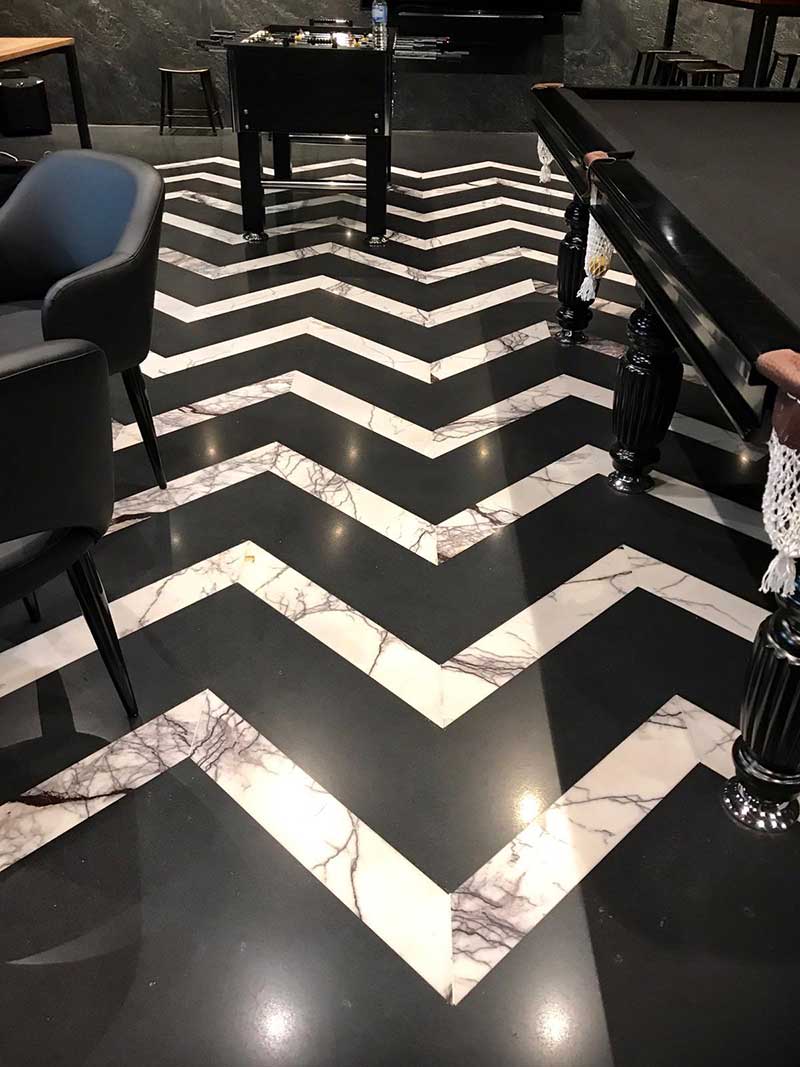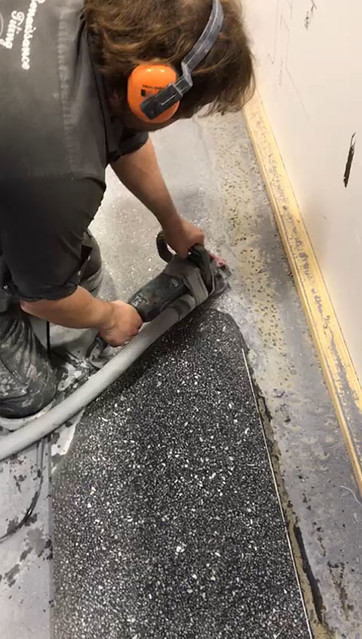A Walk Through on the Extreme Terrazzo Tiling
What is the Extreme Terrazzo range
Ren Tiling have the distribution rights of Sib Extreme Terrazzo which here in Australia is called Extreme Terrazzo.
The whole range of Sib Extreme Terrazzo is from 15 to 20 millimeters, and extremely hard flooring product compared to other products which are thinner that can be laid on walls and floors with different textures and styles.
That’s called micro terrazzo.
Let’s talk about the extreme terrazzo. Extreme terrazzo is laid 15 to 20 millimeters, mixed with marble chips ranging from one millimeter all the way up to 25 millimeters, depending on what the client decides.
The floor is laid at 15 to 20 millimeters and i’s mineral-based. It’s not epoxy-based. It has a small mineral base and is all-natural products used. No artificial compounds, no resins, or anything similar in the product.
Natural, Stronger Flooring with Extreme Terrazzo
So, it lasts longer?
Well, it’s natural. It’s close as possible to the original terrazzo of a natural visual appearance. Look, it is natural and there are special compounds used. Chemists have made up special compounds where there’s no shrinkage at all whatsoever in the product.
It does not shrink, it doesn’t crack and possess a natural appearance. Moreover, the megapascal (MPa) is 100 MPa, which is five times harder than standard concrete.
So you can do endless colors, endless panels, it’s just up to your creative imagination.
Endless Terrazzo Color Possibilities
We can have an endless standard range, you can have a custom range or you can have a specific colour range made specifically for what you need.
Option for No Joints
So, the beauty about it is, as we laid it in the Adelaide Casino, they didn’t want any expansion joints.
As a result, we were able to lay the extreme terrazzo with no expansion joints as there’s no contraction in the product at all.
Why it’s like this is because of flexural strength. It is called F20. Standard concrete has a flexural strength of F5. That’s the difference!
Advantages of Extreme Terrazzo
- there can be no cracks forming
- no shrinkage
- no movement and,
- no joints required.
You can still put joints in for aesthetic reasons if you want to ‘class up’ a flooring to have different colours. And yes, you can do that as well. You can do whatever your imagination desires. So that’s the extreme terrazzo, which can be laid on floors and you can do terrazzo benchtops.
Now, the next range from the extreme range is called extreme flow. Extreme flow, again, has no shrinkage. It’s not as high in MPa. It’s 70MPa but it looks more like a porcelain tile.
Imagine a big porcelain tile laid with no joints?
That’s what it looks like. The marble chips, maybe 0.3 of a millimeter you can hardly see the marble chips. It looks like a polished porcelain tile but with no joints, and that one there is laid at 15 millimeters.
Finally. we move on to the micro terrazzo or micro cement and Venetian plaster, which is a wall application.
Micro Terrazzo
Now, the difference with this range compared to the Venetian plaster is that this is micro terrazzo/micro cement is very high in MPa at 60 to 70MPa. Very, very fine marble chips. If you require to make the wall look like a Caesar stone or you can make it simply appear as a burnished concrete look nice and flat.
Then we machine it with polishing pads. The reason we do this is the benefits of polishing with a polishing pad if a client scratches the wall or we want to rejuvenate the wall.
We can simply go with the polishing diamonds, buff out the scratches, and if you mark the flooring it can be later restored to brand new.
Terrazzo vs Venetian Plaster
As with Venetian plaster, it’s very delicate, although it’s very beautiful. There are applications we should have and shouldn’t have it for example the bathroom.
You can’t polish out the Venetian plaster because it’s too soft and it just doesn’t take to polishing, so that’s the primary difference between the two.
Venetian plaster looks great, however, we’d only apply that on feature stone walls or top of the mantelpiece, a fireplace along the wall as an example. Our recommendation is not to have it in bathrooms because it’s not as hard as the micro terrazzo.
We cater for also stone floors. We lay the floors at 4 -6 millimeters, even though it’s thin people don’t understand. They think that’s too thin! That won’t work on the floor.
Not true. The product is designed so hard that you can lay it thin. The reason why you can lay this so thin is that if you look at the Mohs scale, the hardness is harder than granite.
The scratch-resistant from the wear is as hard as granite! The 4- 6 millimeters thick floor, it won’t disappear on the floor. That’s how hard it is. As a result, it’s a lifetime application and being 4 – 6 mm.
Secondly, the product is not as expensive.
Venetian Plaster is a product that can be more affordable and less labor-intensive. You don’t have to machine it with metal diamonds as you do with the extreme terrazzo. You go with resin diamonds and you can buff the floor and that’s another beautiful aesthetic look to the floor.
The whole Extreme Terrazzo range covers whether you want the top of the list with the extreme terrazzo, which is if you want to invest more money to lay, and if your budget doesn’t meet that there’s the micro terrazzo range, which was evident recently in Poland. They laid a large shopping center four thousand square meters with the micro terrazzo and to this day it still stands.
So how does this differ from standard terrazzo?
Standard terrazzo has shrinkage. The standard terrazzo which we used to lay a lot of is yes, has shrinkage.
Now, in order for you to get the right cement for standard terrazzo, you have to import the cement from Italy or Denmark and it’s very expensive. Just to buy a bag is between 50 and 60 AUD dollars of cement.
You then have to lay traditional terrazzo on a ‘step down’ on your concrete floor and you have to have a screed. If they have a minimum of 150 mm screed, then you lay your terrazzo on top of that screed.
With extreme terrazzo, you can lay directly on top of the slab. Therefore you save time, money and there’s no shrinkage, whereas in the standard terrazzo you need expansion joints at least every 10 to 15 square meters, otherwise it’ll crack.
That’s the difference with standard terrazzo.
Call us today for a quote for your next project.

























